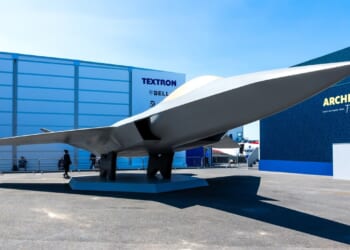A single torpedo salvo from I-19, often called one of the most damaging in submarine warfare history, singlehandedly crippled an entire carrier task force.
Commissioned in the early days of World War II, the Imperial Japanese Navy’s (IJN) I-19 submarine, classified as a Type B1 submarine, was a scourge of the seas for Allied forces fighting against the Empire of Japan. While not the most advanced submarine in Japan’s fleet, it was one of the most successful in the war.
Designed for long-range reconnaissance, commerce raiding, and direct attacks on enemy ships, I-19 combined many capabilities that made it very unique and effective. I-19 served from 1941-43, plaguing Allied shipping the entire time.
I-19’s origins trace back to Japan’s prewar naval buildup, driven by the desire to counter perceived American naval dominance in the Pacific. Laid down on March 15, 1938, at the Mitsubishi Heavy Industries shipyard in Kobe, the submarine was launched on September 16, 1939, and completed on April 28, 1941. Attached to the Yokosuka Naval District and assigned to the Japanese Sixth Fleet, I-19 displaced 2,584 tons when surfaced and 3,654 tons when submerged.
I-19 Terrorized the US Navy Across the Pacific
Two diesel engines producing 12,400 horsepower for surface travel and electric motors yielding 2,000 horsepower when submerged powered this sub. This propulsion system allowed for speeds at the surface of up to 23.5 knots (27 miles per hour) and eight knots (nine mph) when submerged. It had an impressive range of up to 14,000 nautical miles (16,110 statute miles) at 16 knots (18 mph). Its test depth reached 100 meters (328 feet), and it carried a crew of 94 officers and men. In essence, the Japanese built I-19 for long-distance transoceanic operations.
I-19’s most significant feature, however, was its advanced weapons package. It featured six 533mm torpedo tubes forward, stocked with 17 torpedoes, including the advanced Type 95 models known for their reliability, extended range, and large warheads capable of dealing catastrophic damage to American surface ships caught unawares.
Additional weaponry included a 140mm deck gun and two 25mm anti-aircraft guns for surface engagements. Uniquely for its class, I-19 could launch a Yokosuka E14Y floatplane from a hangar forward of the conning tower, enabling aerial reconnaissance that extended its operational reach beyond the horizon.
These interesting specifications made the B1-class submarines, of which I-19 was part, the largest class of subs in the IJN fleet. There were 20 Type B1 vessels, although 95 percent of these submarines were lost by the time the war ended (underscoring the high-risk nature of submarine warfare).
I-19’s operational history began shortly after Japan’s entry into the war, showcasing its importance in both offensive and support roles. In December 1941, shortly after the Pearl Harbor attack, I-19 was deployed off the California coast as part of a broader IJN effort to disrupt American shipping. On December 22, it targeted the tanker SS H.M. Storey with three torpedoes, all of which missed, but later damaged the lumber carrier SS Absaroka, forcing it to beach.
Evading depth charges from US Navy aircraft, I-19 demonstrated the evasive capabilities that would define its career. In February 1942, I-19 participated in Operation K, a planned aerial bombing of Pearl Harbor. Its floatplane conducted a nighttime reconnaissance over the harbor on February 23, and on March 4, I-19 also served as a radio beacon at French Frigate Shoals to guide Japanese flying boats. Although weather largely foiled the bombing, the mission highlighted I-19’s reconnaissance value.
By June 1942, I-19 supported the Aleutian Islands campaign, a diversionary effort tied to the Midway operation, patrolling northern waters to screen Japanese forces. But its most celebrated action did not occur until the historic Guadalcanal campaign, a grueling attritional battle for dominance over the Solomon Islands.
The Most Damaging Torpedo Salvo in the History of Sub Warfare
On September 15 of that year, under Commander Kinashi Takakazu, I-19 encountered Task Force 61, including the aircraft carrier USS Wasp, the battleship USS North Carolina, and destroyer USS O’Brien.
From a range of around 1,000 yards, I-19 fired a spread of six Type 95 torpedoes in a fan pattern—a standard tactic to maximize hits on clustered targets. The results were catastrophic for the Allies: three torpedoes struck Wasp, igniting massive fires and explosions that led to its sinking, with 193 crewmen killed or missing and 367 wounded.
Another torpedo hit the USS O’Brien, causing structural damage that doomed the American destroyer to sink a month later. A fifth torpedo hit the battleship North Carolina, damaging the hull and forcing it out of action for repairs. This single salvo, often called one of the most damaging in submarine warfare history, crippled a carrier task force and underscored the threat posed by Japanese submarines during Guadalcanal.
Following that triumph, I-19 shifted to support roles in the “Tokyo Express,” the IJN’s nocturnal supply runs to its embattled forces fighting on Guadalcanal. I-19 completed three successful supply missions, transporting 52 tons of critical provisions.
Relocated to patrols off Fiji in April 1943, I-19 resumed commerce raiding with deadly efficiency. On April 30, it sank the Liberty ship SS Phoebe A. Hearst; on May 2, I-19 severely damaged the SS William Williams; and on May 16, she torpedoes the SS William K. Vanderbilt, which ultimately sank. I-19 later attacked the SS M.H. DeYoung, though the vessel was towed to safety, she was deemed to be damaged beyond repair.
How the US Navy Finally Got I-19
The submarine’s luck finally ran out on November 25, 1943. During patrols near the Gilbert Islands amid the US invasion of Tarawa and Makin, she was detected by the destroyer USS Radford west of Makin. In the hours that followed, I-19 was subjected to a withering barrage of depth charges from the Radford. Oil slicks and debris confirmed the sinking of the I-19, with the loss of all 105 crewmembers. It was officially stricken from the IJN list on April 1, 1944.
Japan’s submarines were a unique threat the US Navy faced in the Second World War. That’s because the IJN used them very differently than how the German Kriegsmarine used their U-Boats. The former employed submarines predominantly in support functions and for reconnaissance missions, rather than the unrestricted commerce warfare that German U-Boats engaged in during the Battle of the Atlantic.
Submarines like I-19 achieved remarkable results through technological superiority and bold tactics by its commanders. Its destruction of high-value targets, including an aircraft carrier, inflicted major strategic setbacks on the Allies while boosting waning Japanese morale during a turning point in the war. Yet as American anti-submarine warfare improved, such successes became rarer, contributing to the IJN’s inevitable decline and defeat.
I-19 remains a symbol of the underwater threat that haunted Allied navies during the war, a testament to the ingenuity and ferocity of Imperial Japan’s naval forces.
About the Author: Brandon J. Weichert
Brandon J. Weichert, a Senior National Security Editor at The National Interest as well as a contributor at Popular Mechanics, who consults regularly with various government institutions and private organizations on geopolitical issues. Weichert’s writings have appeared in multiple publications, including the Washington Times, National Review, The American Spectator, MSN, the Asia Times, and countless others. His books include Winning Space: How America Remains a Superpower, Biohacked: China’s Race to Control Life, and The Shadow War: Iran’s Quest for Supremacy. His newest book, A Disaster of Our Own Making: How the West Lost Ukraine is available for purchase wherever books are sold. He can be followed via Twitter @WeTheBrandon.
Image: Wikimedia Commons.
















